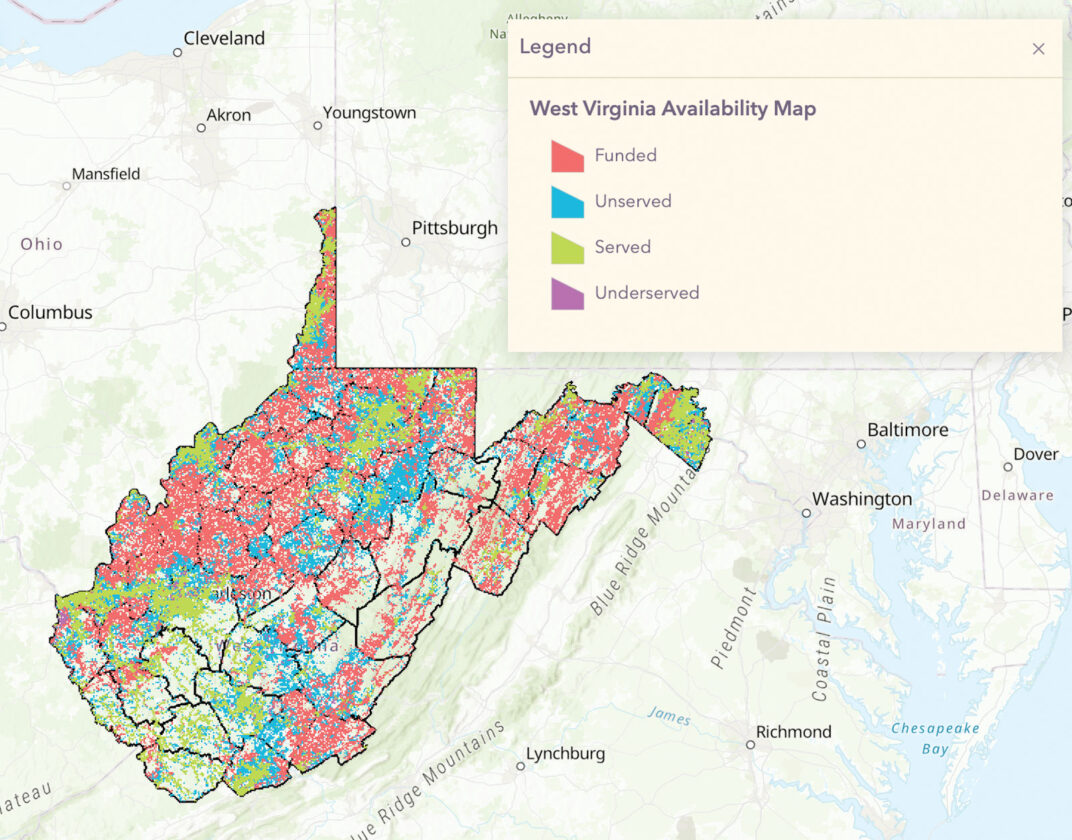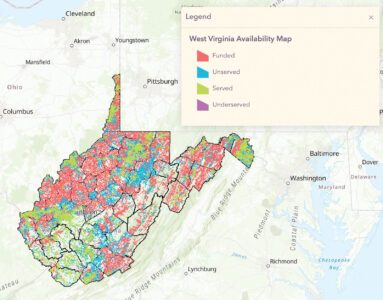West Virginia federal broadband grant proposal will only use half of funds

The West Virginia Office of Broadband maintains a map and dashboard showing areas of the state being served by broadband, areas that are unserved or underserved, and areas where state and federal broadband projects are underway. (Graphic courtesy of WV Office of Broadband)
CHARLESTON — West Virginia was awarded $1.2 billion through a 2023 federal broadband expansion program, but the latest proposal by the state only plans to spend half of that to connect unserved and underserved parts of the state. Earlier this week, Gov. Patrick Morrisey announced that the state was taking public comments through Tuesday, Aug. 26, on its final proposal to the U.S. Department of Commerce’s National Telecommunications and Information Administration (NTIA) for the federal Broadband Equity, Access, and Deployment (BEAD) program. “If you care about expanding high-speed broadband to West Virginia, this is an important announcement,” Morrisey said in a video message posted to social media Tuesday. “We’ve been working very closely with the Trump administration to bring additional high-speed networks to West Virginia, and now we’re making progress. “We now have a public comment period that’s going to give West Virginians the opportunity to weigh in on their thoughts on our proposal,” Morrisey continued. “Then it will get submitted finally and formally to the Trump administration. We’ve been having a lot of discussions with the Trump administration, and this is a big deal.” According to the state’s BEAD draft final proposal, the West Virginia Office of Broadband within the state Department of Commerce will award $625 million of the $1.2 billion BEAD grant to nine provisional subgrantees to expand high-speed broadband to 73,701 locations across the state. These awardees, which were not named in the report, will provide $186 million towards these projects, with West Virginia kicking in $37.5 million in funding made possible by the Appalachian Regional Commission. “This process has resulted in substantial cost savings and will require subgrants that total only approximately half of the $1.21 billion allocated to West Virginia for BEAD under the Infrastructure Investment and Jobs Act (IIJA),” according to the draft report. As for the remaining $575 million left over in BEAD funding, the state is hoping that NTIA will provide guidance on other uses for the funds. “The Policy Notice states that funding for other allowable uses of this funding is under review and NTIA will issue updated guidance in the future. WVDED looks forward to the future opportunity to respond with support for initiatives that will deepen the impact of these broadband infrastructure investments for West Virginia.” High-speed broadband is defined as speeds of no less than 100 megabits per second (Mbps) for download and 20 Mbps for upload; a latency of no more than 100 milliseconds; and ability to easily scale over time to meet evolving connectivity needs of households and businesses, support the deployment of 5G, future wireless technologies, and other advanced services. The state included a five-point plan in its draft BEAD final proposal to reduce broadband deployment costs and barriers to expansion. These include improvements to the state’s Dig Once policy that includes fiber broadband lines being laid in other infrastructure projects; a streamlined permitting process; creating a broadband construction guide for companies; and improved coordination across state departments and agencies, and local governments. Another part of the state’s five-point plan includes addressing issues between internet service providers and electric and telecommunication utilities on new pole attachments. The West Virginia Public Service Commission created a Pole Attachment Working Group to advise the PSC and serve as a coordination forum between internet service providers (ISPs) and utility pole owners. “(The Office of Broadband) would collaborate with pole-owning utilities and the West Virginia Public Service Commission to expedite the pole attachment application process, decreasing delays and eliminating unnecessary costs,” the report stated. At the end of July, the PSC issued a ruling in a dispute between ISPs and pole owners. The PSC prohibited Appalachian Power from enforcing a “pre-existing violation” policy to place the cost of repairs or replacement of utility poles on internet service providers, instead of the electric utility that owns the poles. Current laws prohibit pole owners from denying access to utility poles to new attachers, such as ISPs, due to safety concerns stemming from pre-existing code violations caused by other attachers. The IIJA, passed by Congress and signed into law in 2021, allocated more than $42 billion to expand high-speed broadband access across the United States. West Virginia was awarded $1.2 billion through the BEAD program in June 2023. The NTIA approved West Virginia’s Volume II Initial Proposal for the BEAD program in April 2024, becoming one of the first three states to have their initial proposals approved. The BEAD final proposals were due on April 18. But Morrisey announced in March that West Virginia was granted a 90-day extension to submit the state’s final BEAD grant proposal. The BEAD program was placed on a pause at the beginning of March by Commerce Secretary Howard Lutnick while the program was being reviewed. The program was accused of favoring some technologies over others, being bogged down by cumbersome regulations and red tape, and being high in cost. The NTIA released updated guidance for the BEAD program in June. The stated goal of the updated guidance is to modify the BEAD program’s implementation, aiming to accelerate broadband deployment and ensure greater value for taxpayer investment by eliminating perceived “non-statutory burdens and red tape” imposed by the prior administration of former President Joe Biden. Key changes from prior guidance include removing specific mandates related to labor practices, climate change, open access, and affordability plans. The updated program also now emphasizes a technology-neutral approach to funding, allowing various broadband technologies to compete on an equal footing for subgrants, and introduces a “Benefit of the Bargain Round” to ensure competitive selection and optimal use of taxpayer funds. The notice also details updates to eligible locations, non-deployment funding, permitting processes, and the modification procedures for proposals to align with these new directives, including specific guidelines for unlicensed fixed wireless and low Earth orbit (LEO) capacity subgrants. Other changes included a mandatory correction to initial state proposals within 30 days; a re-evaluation of target locations, primarily involving the removal of already served areas or those served by compliant unlicensed fixed wireless; and a new deadline for final proposals within 90 days. Morrisey has said his office has been in constant communication with the administration of President Donald Trump and Lutnick about changes being considered for the BEAD program. “We went in very early and worked closely with the Trump administration to get near the front of the line,” Morrisey said. “Right now, we’re about the third fastest here in the country in terms of getting our applications in. This is big, and we want to make sure we finish the job.” West Virginia has several broadband expansion projects underway through different state and federal pots of money, including projects funded by the NTIA, the federal American Rescue Plan Act, the U.S. Department of House and Urban Development, the U.S. Department of Agriculture, and the Federal Communications Commission. Through these programs, West Virginia has an additional $2 billion dollars for ongoing broadband expansion Steven Allen Adams can be reached at sadams@newsandsentinel.com.




